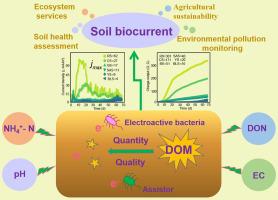当前位置:
X-MOL 学术
›
Electrochem. Commun.
›
论文详情
Our official English website, www.x-mol.net, welcomes your feedback! (Note: you will need to create a separate account there.)
Response of biocurrent conduction to soil microenvironment
Electrochemistry Communications ( IF 4.7 ) Pub Date : 2024-02-21 , DOI: 10.1016/j.elecom.2024.107681 Side Yang , Danfeng Li , Xin Yu , Mohan Bai , Huike Ye , Yang Sun , Lixia Zhao , Yali Chen , Xiaojing Li , Yongtao Li
Electrochemistry Communications ( IF 4.7 ) Pub Date : 2024-02-21 , DOI: 10.1016/j.elecom.2024.107681 Side Yang , Danfeng Li , Xin Yu , Mohan Bai , Huike Ye , Yang Sun , Lixia Zhao , Yali Chen , Xiaojing Li , Yongtao Li

|
The biocurrent generated by soil extracellular electron transfer (EET) partly drives biogeochemical cycles and controls soil quality. However, it is unclear how the soil abiotic and biotic conditions affect the biocurrent conduction. In this study, the response relationship of soil microenvironment and biocurrent was studied. The results showed that red soil exhibited the optimal electron transfer efficiency, as evidenced by the maximum current density and accumulated charge output, with increments of 56–93 % and 80–2800 %, respectively, compared with the other five types of soils. Soil physicochemical properties were the most important factor on the biocurrent generation, and further the quantity and bioavailability of dissolved organic matter, NH-N content, and lower pH were predictive indicators for the exoelectrogenic processes of soils. In addition, the high soil biocurrent was likely determined by a complex synergistic network of the transformation of carbon and nitrogen, electroactive bacteria involving the functions of cell wall/membrane and cytochrome enzyme metabolism and transport related EET process. Overall, we provide an insight into the relationship among soil biocurrent conduction, physicochemical properties, bacteria community and metabolic function, and a support for bioelectrochemical technology application.
中文翻译:

生物电流传导对土壤微环境的响应
土壤细胞外电子转移(EET)产生的生物电流部分驱动生物地球化学循环并控制土壤质量。然而,目前尚不清楚土壤非生物和生物条件如何影响生物电流传导。本研究主要研究土壤微环境与生物电流的响应关系。结果表明,与其他五种土壤相比,红壤表现出最佳的电子转移效率,最大电流密度和累积电荷输出分别增加了56%~93%和80%~2800%。土壤理化性质是影响生物电流产生的最重要因素,溶解有机物的数量和生物有效性、NH-N含量和较低的pH值是土壤外生电过程的预测指标。此外,高土壤生物电流可能是由碳和氮转化、涉及细胞壁/膜功能的电活性细菌以及细胞色素酶代谢和运输相关的EET过程的复杂协同网络决定的。总体而言,我们深入了解土壤生物电流传导、理化性质、细菌群落和代谢功能之间的关系,为生物电化学技术的应用提供支持。
更新日期:2024-02-21
中文翻译:

生物电流传导对土壤微环境的响应
土壤细胞外电子转移(EET)产生的生物电流部分驱动生物地球化学循环并控制土壤质量。然而,目前尚不清楚土壤非生物和生物条件如何影响生物电流传导。本研究主要研究土壤微环境与生物电流的响应关系。结果表明,与其他五种土壤相比,红壤表现出最佳的电子转移效率,最大电流密度和累积电荷输出分别增加了56%~93%和80%~2800%。土壤理化性质是影响生物电流产生的最重要因素,溶解有机物的数量和生物有效性、NH-N含量和较低的pH值是土壤外生电过程的预测指标。此外,高土壤生物电流可能是由碳和氮转化、涉及细胞壁/膜功能的电活性细菌以及细胞色素酶代谢和运输相关的EET过程的复杂协同网络决定的。总体而言,我们深入了解土壤生物电流传导、理化性质、细菌群落和代谢功能之间的关系,为生物电化学技术的应用提供支持。











































 京公网安备 11010802027423号
京公网安备 11010802027423号